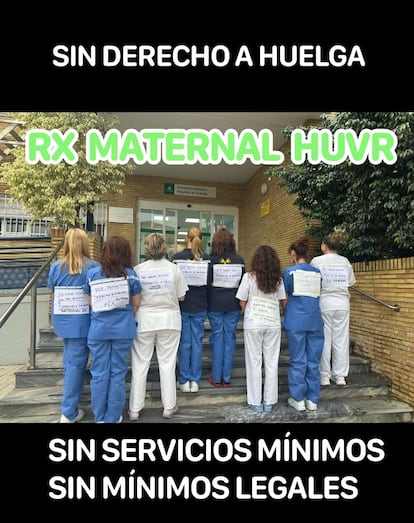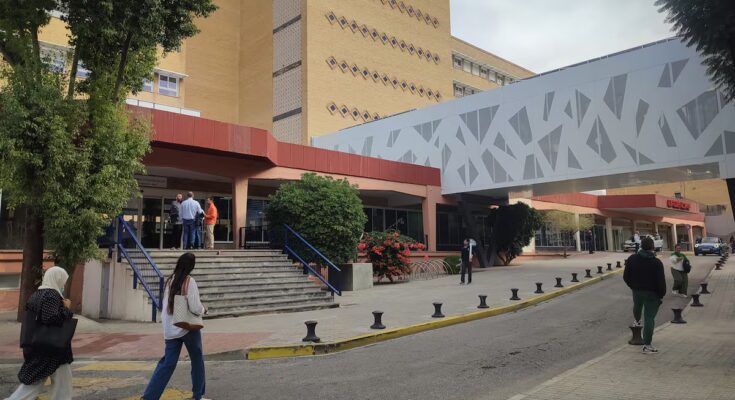The lack of staff in the Radiology Service of the Virgen del Rocío Hospital, the epicenter of the screening crisis plaguing Andalusia’s public health system, has increased the wait women have to endure to undergo a mammogram even when symptoms such as a breast lump are detected.
The total number of patients waiting for an appointment to undergo tests at the doctor’s request stood at 2,415 last week, a figure that is 950 more than at the end of October last year (65% more), according to internal data from the largest community health center, to which EL PAÍS had access.
This growth is even more important among women who wait more than 30 days to find out when to have the diagnostic test, which went from 780 to 1,690 in just 12 months: the number of patients with the longest delay has doubled.
The average wait for a mammogram has grown in the same period from 64 days to 85 (33% more). In reality, the delay is longer, since, when they are finally called to give them the day and time to take the test, this date can be weeks or even months later.

These data are particularly relevant for two reasons. The first is that they reveal a widespread non-compliance with decree 96/2004, which establishes the guarantee that women whose family doctor or specialist requests a mammogram in Andalusia must have it done within a maximum of 30 days.
The second, more important, is that these tests are requested when there is a clinical suspicion on the part of the doctor that the woman may have cancer due to the symptoms she presents, the most common of which is a lump in the breast. In these cases, the malignancy rate – the percentage of patients who are finally diagnosed with breast cancer – approaches 20%, according to the figure most accepted by specialists. This percentage multiplies by 10 the diagnoses made thanks to breast cancer screening, in which tests are performed on women without symptoms and the malignancy rate is around 2%.
If the screening crisis in Andalusia – where 97% of the 2,317 women affected are patients of the Virgen del Rocío – has revealed serious shortcomings in the management and communication of doubtful cases, these new data reveal important and growing delays in performing mammograms on women even when there is already clinical suspicion that they may be suffering from cancer. A delay, moreover, of which there is no public news because for five years the Junta de Andalucía has not published the waiting list for diagnostic tests, a circumstance which prevents these figures from being quantified and compared.
The common cause in both cases is the collapse that these tests have suffered in the Virgen del Rocío Radiology service in recent years, mainly due to lack of staff. Two sources within the center agree that Javier Castell, the head of the service who was removed from office at the start of the crisis, has been unsuccessfully alerting the center’s management over the past two years that staff reductions made it impossible to dispose of all the evidence coming into the service.
“Castell complained that there were days when the service machinery stopped due to lack of staff while the waiting list did not stop growing. And he asked for more professionals to be hired, please,” explains one of these sources. But of the three specialists trained last year in the Radiodiagnosis service, for example, none have been hired, union sources underline.
The cars stopped in the afternoon

It is precisely now that the delays in the diagnosis of breast cancer screening have emerged, that the government of Andalusia has launched several plans to speed up the response to those affected with dubious results, with measures ranging from the hiring of staff to continuity of care – evening and weekend work.
The pressure to give up work is such that the radiology technicians of the breast unit were prevented from exercising the right to strike, called throughout Spain on 30 and 31 October and 3 and 4 November by the unions of senior healthcare technicians. It was reported by the same people affected with a photo in which they posed with their backs to themselves with signs claiming the right to stop work.
“The strike was carried out with minimal abuse and a lot of coercion”, indicates a union source from the hospital. “They did not offer any alternatives, they imposed 100% minimum services and urged them to put themselves in the shoes of the women affected by the screening to justify the measure,” says another interlocutor.
Since the plan was launched, at Virgen del Rocío all the radiologists in the breast cancer prevention program have been working every afternoon so that doubtful screening results can undergo a second test before November 15th. This is an extension of shifts which today seems an exception to resolve this health crisis, but which was common until a few years ago.
“Continuity of care has always existed, but in the last two years it has been reduced to 50%, that is, the maximum that could be worked was two afternoons a week”, explains a specialist who knows how this program works, who requests anonymity.
The situation at the Virgen del Rocío was until now a sort of vicious circle from which it was almost impossible to escape, sources from the center add: “An overcrowded service from which there were people leaving due to the working conditions. Many asked for a reduction in working hours, also to work in the afternoon in the private sector, where there was a lot of money due to the increase in reporting made by the Andalusian government. But these losses were not covered, also due to the cuts in personnel expenses imposed by the Andalusian Health Service (SAS) and partly due to the shortage of radiologists on the market which the same reports had contributed to worsening”.
A lack of incentives whose consequences are explained by another healthcare professional consulted. “Before we were paid the so-called exclusivity to remain in the public, which was not such a large sum. But now with self-concerts (increased activity in public hospitals, which includes financial incentives for professionals, even if they have problems receiving them) the situation does not compensate at all. Those who remain in the public are out of absolute commitment”, he indicates.
“The SAS specialists, many of them, work for private clinics, it’s a sort of bilocation: in the morning I’m at SAS, which pays my salary, where I have my place, my supplements, where I contribute to my pension, but then I ask for a reduction in hours and I go to the private ones, which attract me with good incentives… And meanwhile, in the public ones, the test machines are left turned off in the afternoon”, he complains.



